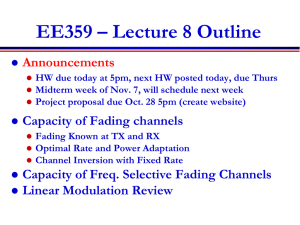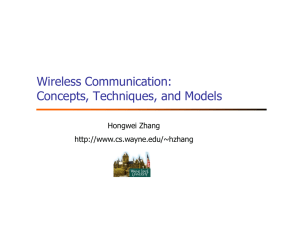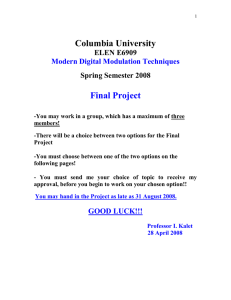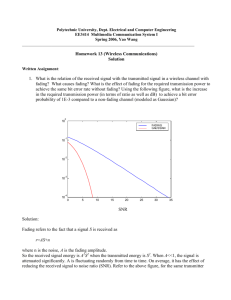BER of OFDM system using concatenated Nakagami–m fading channel
advertisement
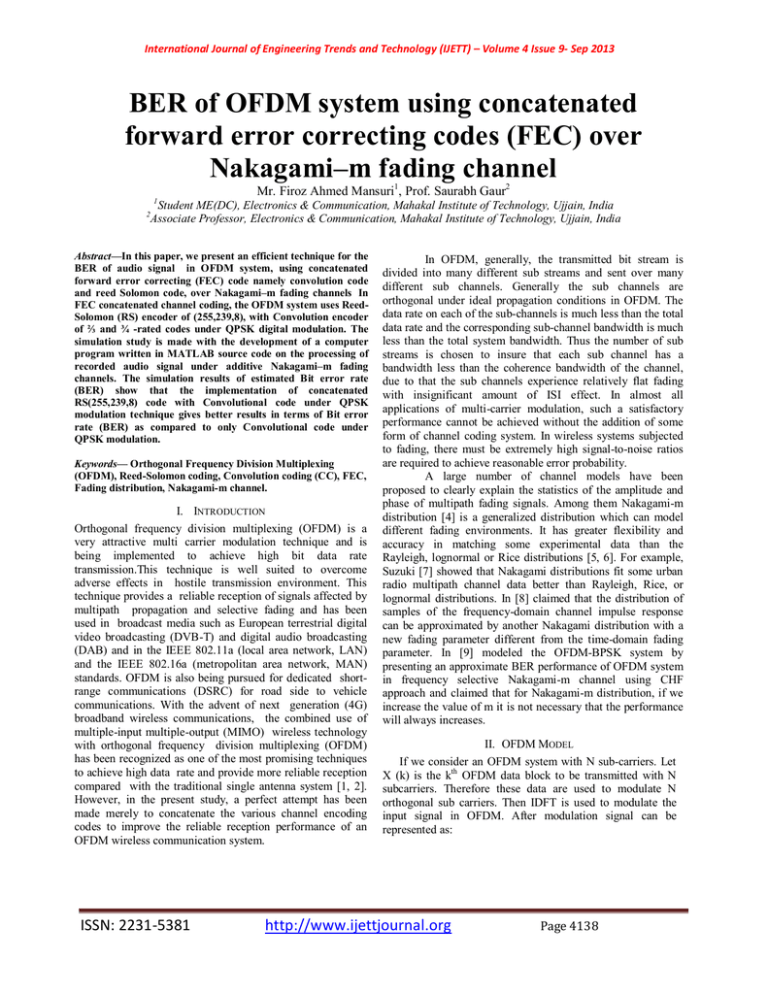
International Journal of Engineering Trends and Technology (IJETT) – Volume 4 Issue 9- Sep 2013 BER of OFDM system using concatenated forward error correcting codes (FEC) over Nakagami–m fading channel Mr. Firoz Ahmed Mansuri1, Prof. Saurabh Gaur2 1 2 Student ME(DC), Electronics & Communication, Mahakal Institute of Technology, Ujjain, India Associate Professor, Electronics & Communication, Mahakal Institute of Technology, Ujjain, India Abstract—In this paper, we present an efficient technique for the BER of audio signal in OFDM system, using concatenated forward error correcting (FEC) code namely convolution code and reed Solomon code, over Nakagami–m fading channels In FEC concatenated channel coding, the OFDM system uses ReedSolomon (RS) encoder of (255,239,8), with Convolution encoder of ⅔ and ¾ -rated codes under QPSK digital modulation. The simulation study is made with the development of a computer program written in MATLAB source code on the processing of recorded audio signal under additive Nakagami–m fading channels. The simulation results of estimated Bit error rate (BER) show that the implementation of concatenated RS(255,239,8) code with Convolutional code under QPSK modulation technique gives better results in terms of Bit error rate (BER) as compared to only Convolutional code under QPSK modulation. Keywords— Orthogonal Frequency Division Multiplexing (OFDM), Reed-Solomon coding, Convolution coding (CC), FEC, Fading distribution, Nakagami-m channel. I. INTRODUCTION Orthogonal frequency division multiplexing (OFDM) is a very attractive multi carrier modulation technique and is being implemented to achieve high bit data rate transmission.This technique is well suited to overcome adverse effects in hostile transmission environment. This technique provides a reliable reception of signals affected by multipath propagation and selective fading and has been used in broadcast media such as European terrestrial digital video broadcasting (DVB-T) and digital audio broadcasting (DAB) and in the IEEE 802.11a (local area network, LAN) and the IEEE 802.16a (metropolitan area network, MAN) standards. OFDM is also being pursued for dedicated shortrange communications (DSRC) for road side to vehicle communications. With the advent of next generation (4G) broadband wireless communications, the combined use of multiple-input multiple-output (MIMO) wireless technology with orthogonal frequency division multiplexing (OFDM) has been recognized as one of the most promising techniques to achieve high data rate and provide more reliable reception compared with the traditional single antenna system [1, 2]. However, in the present study, a perfect attempt has been made merely to concatenate the various channel encoding codes to improve the reliable reception performance of an OFDM wireless communication system. ISSN: 2231-5381 In OFDM, generally, the transmitted bit stream is divided into many different sub streams and sent over many different sub channels. Generally the sub channels are orthogonal under ideal propagation conditions in OFDM. The data rate on each of the sub-channels is much less than the total data rate and the corresponding sub-channel bandwidth is much less than the total system bandwidth. Thus the number of sub streams is chosen to insure that each sub channel has a bandwidth less than the coherence bandwidth of the channel, due to that the sub channels experience relatively flat fading with insignificant amount of ISI effect. In almost all applications of multi-carrier modulation, such a satisfactory performance cannot be achieved without the addition of some form of channel coding system. In wireless systems subjected to fading, there must be extremely high signal-to-noise ratios are required to achieve reasonable error probability. A large number of channel models have been proposed to clearly explain the statistics of the amplitude and phase of multipath fading signals. Among them Nakagami-m distribution [4] is a generalized distribution which can model different fading environments. It has greater flexibility and accuracy in matching some experimental data than the Rayleigh, lognormal or Rice distributions [5, 6]. For example, Suzuki [7] showed that Nakagami distributions fit some urban radio multipath channel data better than Rayleigh, Rice, or lognormal distributions. In [8] claimed that the distribution of samples of the frequency-domain channel impulse response can be approximated by another Nakagami distribution with a new fading parameter different from the time-domain fading parameter. In [9] modeled the OFDM-BPSK system by presenting an approximate BER performance of OFDM system in frequency selective Nakagami-m channel using CHF approach and claimed that for Nakagami-m distribution, if we increase the value of m it is not necessary that the performance will always increases. II. OFDM MODEL If we consider an OFDM system with N sub-carriers. Let X (k) is the kth OFDM data block to be transmitted with N subcarriers. Therefore these data are used to modulate N orthogonal sub carriers. Then IDFT is used to modulate the input signal in OFDM. After modulation signal can be represented as: http://www.ijettjournal.org Page 4138 International Journal of Engineering Trends and Technology (IJETT) – Volume 4 Issue 9- Sep 2013 [ ]= 1 [ ] / = 0, 1, … − 1(1) Field Genarator Polynomial;: P(x) = x8 + x4 + x3 + x2 + 1 (4) The encoder block diagram is shown in figure 1. Coefficients g0 to g15 corresponds to the coefficients of g(x). The wave propagate and interact with obstacle present in nature and the signal can be delayed, reflected, scattered, and diffracted. This phenomenon is known as multipath propagation. The channel impulse response of a multipath ( ) fading channel is modeled as a ℎ( ) . In our paper we assume that frequency synchronization are achieved at the receiver side r (n) can be represented in frequency domain as: R(k) = X(k) + N (2) Where N is an independent identically distributed (i.i.d) complex Gaussian noise component with zero mean and unit variance. The amplitude of H (k) is modelled as a Nakagami random variable with PDF. III. FORWARD ERROR CORRECTION In this paper we are using Wireless-MAN OFDM PHY layer IEEE802.16a. According to the IEEE802.16a OFDM PHY specification, the Reed-Solomon code concatenates with convolutional code to deal with burst error is punctured and shortened to fit the 6 mandatory modulation requirements. The RS code used here is (255,239,8) with code generator polynomial g(x) and field generator polynomial p(x) for burst errors [3] . The randomizer and interleaver is also defined for the transmit power and subcarrier interleaver reasons. This section introduces randomizer, RS code, convolutional code, and interleaver defined in Wireless-OFDM PHY Layer. The randomizer block diagram is shown in figure 1. The pseudo random binary sequence of the randomizer is 1+ x14+x15.The source data bytes are symbol by symbol partitioned and fed into FEC block according to Table 1. The un-coded symbol contains one byte less than it is defined. This is because the convolutional encoder needs at least six zero bits to make its register state back to zero. The data output of randomizer is bit by bit and one byte of 0x00 is tailed at the end of randomizer output bits. In the Dl., the scrambler 10101010000000 shall be re-initialized : Fig. 2 Reed-Solomon encoder There are 16 registers in the divider block, the output of RS encoder is parity bytes first and then the FIFO output source bytes. All add and multiply operations are in the Galois Field according to the field generator polynomial defined above. Figure 3 shows the defined convolutional encoder block diagram. Fig. 3 Convolutional encoder The block interleaver distributes adjacent bits into data subcarriers. The size of the block interleaver depends on the modulation and subchannel partition, which is called the number of coded bit per symbol Ncbps There are two permutation steps defined to interleaver and deinterleaver. For the interleaver, The first permutation is defined by : m = (Ncbps/16) . kmod(16) + floor (k/16) The second permutation is defined by: J = s.floor(m/s) + (m + Ncbps – floor(16.m/ Ncbps))mod s where the k and m are the input and output index in the first permutation, the j and m are the output and input index. If the modulation scheme is QPSK, s is equal to 1. For the deinterleaver, reverse the second permutation and first permutation steps. The decoding of FEC in the receiver used in this paper contains the Viterbi and the Reed-Solomon decoder. The Viterbi decoder architecture is shown in figure 4. Fig. 1 Randomizer The Reed-Solomon code defined in Wireless-MAN OFDM PHY Layer is listed below. Code Generator Polynomial: g(x) =( x+ λ0) ( x+ λ1) ( x+ λ2 )...( x+ λ2T-1), λ = 02HEX (3) ISSN: 2231-5381 http://www.ijettjournal.org Fig. 4 Viterbi decoder Page 4139 International Journal of Engineering Trends and Technology (IJETT) – Volume 4 Issue 9- Sep 2013 In the branch metric (BM) block, de-punctured soft value input pair is calculated to form four possible branch metric values for add-compare-select (ACS) block. The survivor path bits are saved into RAM and the windowing trace back outputs bit by bit. V. SIMULATION ARCHITECTURE For the transceiver simulation, a detailed signal flow block diagram is shown in figure 2. Fig. 5 Reed-Solomon decoder The Reed-Solomon decoder design block is shown in figure 5. Because of the parity bytes are transmitted first in the Transmitter and passes data bytes to syndrome calculator first, finally the parity bytes are concatenated at the end of data bytes. The proposed RS decoder is also called the shortened and punctured RS decoder. Because of the punctured bytes in parity part, the syndrome calculator output must multiply to a well known polynomial, the erasure locator polynomial. If the modified syndrome polynomial is zero, the no error checker outputs the received data part bytes directly, else enable the ME block. The ME key equation solver finds the great common divider of the key equation and multiplies erasure locator polynomial for the erasure locator output sigma(x). A serial to parallel with index adjustment multiplier for omega(x) and sigma(x) are defined for Chien search and Forney algorithm. The Chien and Forney algorithm finally compute and output the error magnitudes and error locations to error correction block for output in the right order. The de-scrambler, also called de-randomizer, uses the same architecture with randomizer in the transmitter. IV. CHANNEL MODEL We assume that the channel between the k-th transmitter and the corresponding receiver is a slowly flat Nakagami-m fading channel for each subcarrier. The channel impulse response for the kth transmitted signal over the uth subcarrier is given by ( ) = ℎ ( − )exp(− ) (5) where ℎ , , and represent the attenuation factor, delay and phase-shift, respectively. The delay of the kth user is assumed to be uniformly distributed over [0, Ts). The Nakagami-m distribution is a versatile statistical distribution, which is capable of modelling a variety of fading environments, such as land mobile, as well as indoor mobile multipath propagation channels and ionospheric radio links [10]. The PDF of the Nakagami-m fading amplitude is given by: ( ) = exp − , ≥ 0 (6) Γ(m)Ω Where, Γ(.) is the Gamma function, Ω = r , is the average power, m is fading parameter and r is Nakagami distribution envelope. Since, The Nakagami-m fading family includes channels as diverse as the one-sided Gaussian fading associated with m = 1/2, the Rayleigh fading having m = 1, and no fading, corresponding to m = ∞. The distribution of the Nakagami-m fading phase is assumed to be uniform over [0, 2π). ISSN: 2231-5381 Fig. 6 Simulation block diagram In figure 6, the coded data bytes and pilots with FFT modulation and CP insertion are transmitted through Nakagami-m fading channel and fed into the proposed receiver. The simulation parameters used are listed below. NFFT = 256, Nused= 200, G = ¼ (guard interval) Number of lower frequency guard subcarriers = 28, Number of higher frequency guard subcarriers=27, QPSK-code rate 1/2, QPSK-code rate 3/4, The FEC scheme of Wireless-MAN OFDM system concatenates the RS code and convolutional code for the proper data bytes into specific modulation purposes. It is interesting to use the RS code only or the convolutional encoder only and replace the concatenated code to see how the concatenated code improving the system performance. In the simulation, some padding bits are needed when occupying either the RS code or convolutional code. The padding bits are in the order of 010101010…0101. For a complete work of simulation, the synchronization procedures had been built into this design. As depicted in figure 6, preamble detection detects the arrival of packet, coarse frequency offset estimation estimates and compensates the frequency offset degree. A short match filter of length 64 is used to find the short preamble boundary and frame boundary, here the frame synchronization is done. Another match filter of length 128, which is called the long match filter, with sliding length of 192 samples finds out the cyclic prefix (CP) length. The fine frequency tuning is compensated by the correlation method with long preamble. Finally, the inner loop receiver design estimates the channel and smooth filtered the soft values for demodulation and then fed to FEC block. With the inner loop receiver, the analysis of Reed-Solomon code and convolutional code to IEEE802.16a is more practical and valuable. VI. SIMULATION RESULT The BER performance of an OFDM system under concatenated FEC over Nakagami-m fading channel is analytically evaluated. By varying the fading parameter m obtaining the BER vs SNR is plotted as shown in figures 7 to 11. The simulation is done for different values of fading parameter m using QPSK modulation and with two coding rates namely ½ and ¾ . These coding rates are overall coding http://www.ijettjournal.org Page 4140 International Journal of Engineering Trends and Technology (IJETT) – Volume 4 Issue 9- Sep 2013 rates. The Simulation results shows that if we use Reed Solomon code with Convolution code then it gives better Bit error rate (BER), Figure 10 : BER Vs. SNR for OFDM-QPSK system for m=5 Figure 7 : BER Vs. SNR for OFDM-QPSK system for m=1 Figure 11 : BER Vs. SNR for OFDM-QPSK system for m=15 Figure 8 : BER Vs. SNR for OFDM-QPSK system for m=1.4 as compared with Convolution code only. It means that concatenated forward error correcting codes Using RS with CC performs better in comparison with CC only for different values of m=1, 1.4, 3, 5 and 15. Another analysis is observed from fig. 7 to 11 that if we increase the coding rate the BER also increases for all values of fading parameter m. VII. CONCLUSION In this paper, we have evaluated the performance of OFDM system using QPSK with OFDM using Nakagami m fading channel distribution. Graphical results show that the comparison of concatenated code to convolution code only figure out how the concatenated code contributes to the performance for different coding rate and fading parameter. So, here the versatility of Nakagami-m fading model of using different values of fading parameters has been proved. The reported BER can be further reduced by using channel estimation or suitable diversity scheme. REFERENCES Figure 9 : BER Vs. SNR for OFDM-QPSK system for m=3 [1] [2] [3] [4] [5] ISSN: 2231-5381 G. L. Stüber, S. W. Mclaughlin, and M. A. Ingram, Broadband MIMO-OFDM wireless communications – Proc. IEEE 92 (2), 271 (2004). W. Zhang, X. -G. Xia and K. B. Letaief, IEEE Wireless Communications 14 (3), 32 (2007). IEEE P802.16a-2003, “Air Interface for Fixed Broadband Wireless Access Systems Part A: Systems between 2-11 GHz,” 1 April, 2003. Popovic, H., Stefanovic, D., Mitic, A., Stefanovic, I., “Some Statistical Characteristics of Nakagami-m Distribution”, 8th International Conf. on Telecom. In Modern Satellite, Cable and Broadcasting Services , 26-28 Sept. 2007 Serbia. Marvin K. Simon, Mohamed- Slim Alouini, “Digital Communication over Fading Channels”, John Willy & Sons, 2000. http://www.ijettjournal.org Page 4141 International Journal of Engineering Trends and Technology (IJETT) – Volume 4 Issue 9- Sep 2013 [6] [7] [8] [9] [10] John G. Proakis, “Digital Communications,” McGraw-Hill, l995. H. Suzuki, “A statistical model for urban multipath propagation”, IEEE Trans. Commun., vol. COM-25, pp. 673-680, July 1977. Z. Kang, K. Yao, and F. Lorenzelli, “Nakagami-m fading modeling in the frequency domain for OFDM system analysis”, IEEE Commun. Lett. , vol. 7, no. 10, pp. 484–486, Oct. 2003. Zheng du,Julian Cheng and Norman C. Beaulieu, “Asymptotic BER performance of OFDM in Frequency Selective Nakagami-m Channels”, IEEE Conference on Vehicular Technology, vol. 1, pp. 612-615,Sept.2004. M.K. Simon, and M. Alouini, “A unified approach to the performance analysis of digital communication over generalized fading channels,” Proceedings of the IEEE, vol. 86, no. 9, pp. 1860-1877, Sep. 1998. ISSN: 2231-5381 http://www.ijettjournal.org Page 4142

